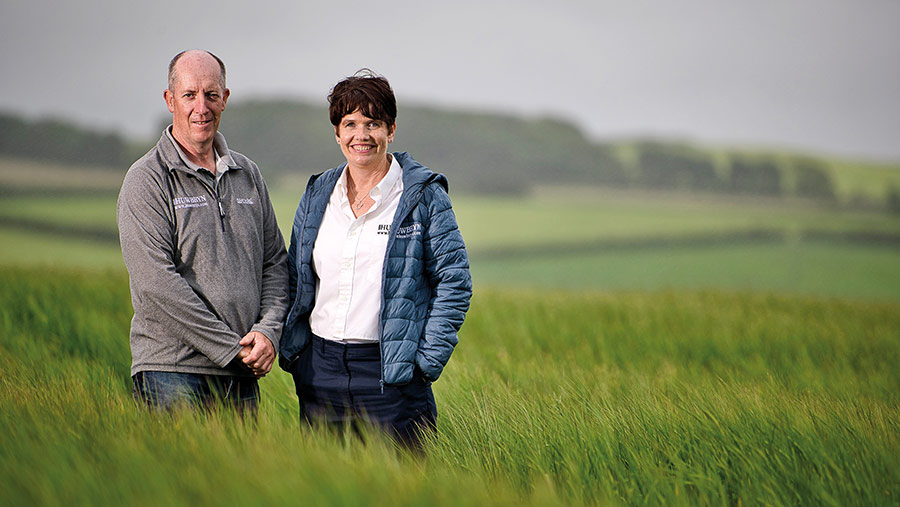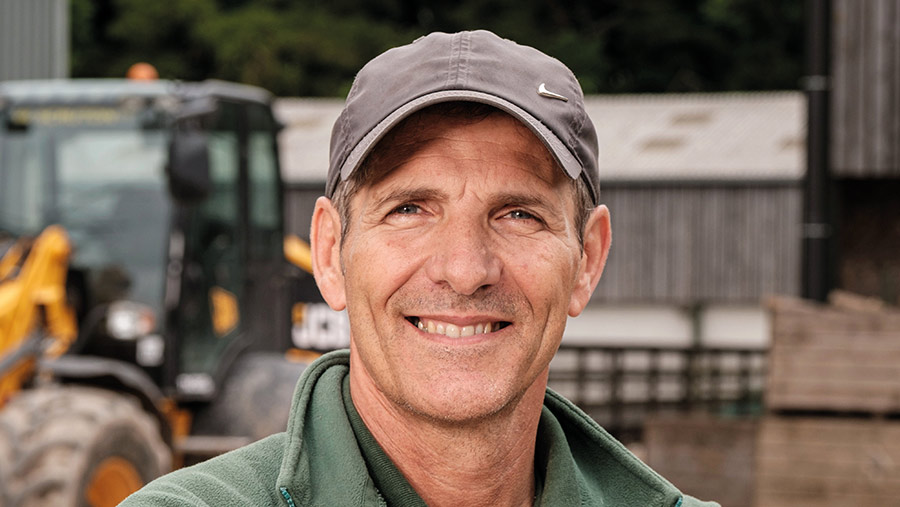Farmers Weekly Awards: Mixed Farmer finalists 2021

This year’s finalists all show a passion for sustainable farming practices, seeking the perfect balance of arable and livestock farming and complementary diversifications.
The finalists:
- The Carlisle family
Rowles Farm, West Berkshire - Huw and Meinir Jones
Bryn Farm, Ceredigion - Paul Temple
Wold Farm, East Yorkshire
The judges:
The judges visited each finalist for a three-hour visit and a tour of their setup. The mixed farmer judges are:
- Esther and Henry Rudge
Last year’s winners - Emma Gillbard
Farmers Weekly arable reporter - Matthew Curry
Managing director, North East Grains
The Carlisle family
Rowles Farm, west Berkshire

The Carlisle family © MAG/Colin Miller
Running a mixed arable and livestock farm in the Berkshire village of West Ilsley, the Carlisle family pride themselves on their close-knit family business, where a new vineyard was recently added to their mix of enterprises.
Peter and Sandra, together with their identical twin sons Will and Tom and daughter Georgie, manage more than 600ha of arable and grassland on Rowles Farm, and contract farm an additional 460ha.
Alongside day-to-day life, the family run a social media page, sharing their farming ways with the public.
On the livestock side they have a breeding flock of 700 North Country Mule ewes and buy in 600 hoggs, along with 50 store cattle, each year, all of which are run in conjunction with Peter’s brother David and his daughter, Tory.
The separate enterprises complement each other well, helping balance the workload throughout the year, with livestock making efficient use of the farm’s permanent grassland, rotation and straw as well as grazing-off stubble turnips and cover crops.
Crop rotation
Cropping includes milling wheat, spring and winter malting barley, winter oilseed rape and stubble turnips for the sheep, while winter linseed made an appearance for the first time this year.
Milling wheats average 11t/ha. The variety Zyatt was grown this year, with 290kg/ha of N applied in four hits, while a four-spray fungicide approach tackles the major disease threats of septoria and yellow rust.
Winter and spring barley average about 8.5t/ha and 7.5t/ha, respectively. A cover-crop trio of phacelia, vetch and radish precedes spring barley, acting as a soil conditioner and additional sheep fodder.
The family use a Horsch Avatar direct drill to sow all of their crops, including 220ha of oilseed rape. In a bid to shield the OSR from cabbage stem flea beetle, barley stubble is left taller and crops are sown with buckwheat as a companion crop.
“Another plus of using the Horsch drill is that we can apply fertiliser down the spout, placing it right next to the seed to kick-start emergence and eliminate additional tractor passes,” says Tom.
Livestock
Lambing takes place indoors during February and March, using a mix of Suffolk, Texel and Charolais terminal sires, with a scanning percentage of 195%.
“Lambing is certainly a labour-intensive period for us but it brings all the family together, where we work as one,” says Will.
This season, the first lambs were sold at £110 each, averaging 36kg, and were fattened off grass, with no creep feed.
Diversification and community
After monitoring the farm’s climate over the past four years, it was decided to plant a 3.5ha vineyard (16,000 vines) of Bacchus and Pinot Noir on the light loam over chalk soils.
“We aim to harvest our first crop of grapes in three years and sell to UK winemakers as part of a co-operative, with the possibility to produce our own bottled wine and add tourism-based elements in the future,” says Georgie.
With the farm located at the very heart of a rural village, tapping into the tourism market certainly offers potential, but the family also play an active role in community life and are affectionately known as West Ilsley’s fourth emergency service.
Promoting British agriculture and reaching out to a wider audience is something Tom, Will and Georgie are particularly keen on, which is why they embarked on their social media journey.
Two years on from making their Instagram account (@rowles_farm) they have nearly reached 10,000 followers and demonstrate farming in a positive light.
The judges say
Rowles Farm is a fantastic example of a mixed farming family business. All the family are involved in various aspects of the business. The energy they have for each enterprise is infectious
Summary
The judges liked
- Excellent close-knit family farming business with a real community spirit
- Effective use of on-farm livestock to help balance workload and utilise permanent grassland
- Great cropping practices and arable yields
- Strategic vineyard diversification enterprise, making the most of the farm’s location and climate
- Fantastic ambassadors for British agriculture, promoting farming practices to the general public
Farm facts
- Rowles Farm incorporates more than 900ha of arable with 700 breeding ewes, 600 bought-in hoggs and 50 store cattle.
- Cropping includes milling winter wheat, spring and winter malting barley, winter oilseed rape and winter linseed. Stubble turnips and cover crops are grown for sheep.
- In 2015, as sitting second-generation tenants, the family were given one month’s advance notice that the farm would be offered for sale in Farmers Weekly, and they managed to buy the land, farmhouse and buildings.
- The family make hay and sell to local racehorse trainers, and let out summer and winter gallops.
- New vineyard enterprise, with 3.5ha of Bacchus and Pinot Noir planted in 2021 with an additional 3ha of Seyval Blanc to be planted in May 2022.
The numbers
- 700 North Country Mule ewes
- 195% Lambing percentage
- 11t/ha Yield of milling wheat
- 3.5ha Size of vineyard planted
- 10,000 Number of followers on the farm’s Instagram account
Huw and Meinir Jones
Bryn Farm, Ceredigion

Huw and Meinir Jones © Richard Stanton
Simple and sustainable is the motto for Huw and Meinir Jones, who farm beef and arable alongside a diversified pet bedding business and holiday lets in Ceredigion, Wales.
Operating a dry coastal farm on the edge of Cardigan Bay, the pair maximise their ability to outwinter their 80 Salers-cross spring calving suckler cows on kale, turnip or forage rape in order to save on housing costs. Progeny are then taken through to fat.
Growing a further 25ha of spring and winter barley, they use the grain and straw on farm, optimising the use of home-grown cereals in return for nutrient-rich manure to help create a sustainable rotation.
Beef enterprise
Cows are housed indoors only for calving, using either Salers or Hereford bulls to produce a docile easy-calving cow, to be crossed with a top 1% Charolais bull for prime fat cattle production.
“Scanning results are 91% and cows calve in a strict 10-week period,” says Huw.
Cattle run on a rotational grazing platform in three groups, which has been a real game changer, allowing the couple to control intakes and quickly identify any shortfalls or excess growth. The best grass fields now grow more than 11t DM/ha, with no artificial fertiliser.
Helped by the precision in grass growth, with measurements taken every two weeks during the growing season, there is no requirement for cattle wormer as pasture burdens are kept significantly low.
Herbal leys were also planted for the first time last year, to help fatten cattle off forage and improve soil health through the plants’ deep rooting systems.
Fat cattle are sold direct to the abattoir, reducing stress before slaughter and enabling this year’s bulls to kill out at 55% to 58%, averaging 340kg deadweight, with prices up to £4.15/kg for U grades.
Soil health
Farming on such light sandy soils, Huw identified that organic matter levels often limited arable yields, prompting him to ditch the plough and move to direct drilling in 2010.
All crops, including grass are now drilled using the 3m Simtek, with organic matter levels now measuring over 10%.
But even with the adoption of direct drilling, Huw and Meinir took the decision to up cattle numbers to 80 by rearing their own replacements and halve the arable area to 25ha as a means of promoting the farm’s long-term sustainability.
After carrying out a farm carbon audit, accounting for the entire farm business, pet bedding enterprise and holiday cottages, the drive to improve soil health has paid off, with a carbon negative score of -75t.
Pet bedding
Huw’s vested interest in value-added enterprises inspired him to diversify into a pet bedding enterprise back in 2004.
What started as cold calling at local pet shops has now developed into a thriving business where Huw and Meinir grow, pack and deliver throughout south Wales.
The business fits exceptionally well within their farming enterprises as any hay or straw which does not meet the desired standard is used back on the farm.
Huw also has an impressive ability to manage and monitor farm performance. He has a great awareness of costs and uses the resources he has to their optimum, in a simple and sustainable manner.
He also takes great pride in training up the next generation, with a number of university placement students having worked on the farm over the years.
The judges say
Too often we think big is best and this business is an excellent example of the opposite. A smaller farm in terms of acres, generating healthy profits by focusing on the detail and developing a point of difference with their diversified pet bedding enterprise
Summary
The judges liked
- Outstanding use of resources – particularly the rotational grazing platform and its optimal grassland management
- Great awareness of costs, with firm focus on measuring and monitoring data
- Simple and sustainable farming practices which suit farm’s location, with workload managed by the pair themselves
- Excellent diversification – pet bedding enterprise, which fits well with existing business
- Impressive improvement to soil health with soil organic matter levels above 10%
Farm facts
- 100ha farm with 80 sucklers and followers, growing green crops and both spring and winter barley
- Coastal location on the edge of Cardigan Bay means cattle are mostly outwintered
- Began direct drilling all crops in 2010, including grass in a bid to improve soil health
- Run a pet bedding business themselves, producing, packing and delivering 2kg bags of hay and straw
- Run a successful holiday let, with another in development for 2022
The numbers
- 91% Scanning result percentage of Salers suckler herd
- 11t DM/ha Yield on best-performing fields, with no artificial fertiliser applied
- >10% Soil organic matter levels
- -75t The farm’s carbon-negative score, accounting for all enterprises
- 0 No cattle are treated with wormer, as the rotational grazing platform keeps worm burdens low
Paul Temple
Wold Farm, East Yorkshire

Paul Temple © Jim Varney
Paul Temple describes himself as not only a mixed beef and arable farmer but also a soil scientist in the making, as he focuses on improving soil biology across his East Yorkshire medium clay loam land.
With a six-year rotation in place at the tenanted farm, crops benefit from organic manure applications from the 550-head beef herd, requiring no bought-in P and K fertiliser.
But with subsides shrinking, Mr Temple decided something had to change which is why he doubled cattle numbers and went down the no-till establishment route, reducing cultivation passes to get his soils working for him.
The shift to conservation agriculture has had many positive impacts, with both machinery and labour costs cut by a third and overall N applications on track to be reduced by 25%.
In fact, winter wheat crops receive just 160kg N/ha and still yield an impressive 10t/ha.
Reduced inputs
Insecticides are being phased out and fungicides are used sparingly as Mr Temple looks to make the most out of soil biology, where organic matters have risen to 7-8%.
“We have not used a T0 spray for four years and just apply two main fungicides at late T1 and T2.5,” he says.
Always producing to a marketing plan, crops are never established purely on speculation.
Wheat is grown for seed on contract, barley for home consumption and vining peas are grown for Swaythorpe Peas.
All crops are established with a Weaving direct drill which replaced the plough, power harrow and Vaderstad drill five years ago.
“One challenge we face is making vining peas work consistently under no-till establishment,” he says.
Beef herd
Much like the arable enterprise, beef cattle are produced to a specific store market.
“For our livestock marketing we have used a variety of direct marketing platforms with repeat buyers for our store stock.”
Stabilisers have been the breed of choice at Wold Farm for many years due to their low cost, good fertility and maternal traits.
Improving cattle infrastructure to optimise efficiency, safety and animal health was a priority when the suckler herd was doubled to 240.
The farm now sets its sights on 300 sucklers managed with the same level of labour, with the ultimate aim of fattening on farm and working with the local abattoir.
Cows calve from February to mid-April, when the arable enterprise is quieter. Cows with calves at foot then graze rented permanent pasture grassland a maximum of 10 miles from home, where Mr Temple has designed easy-to-use handling facilities on off-ground.
Calves are weaned at 300-340kg and fed a total mixed ration, with daily liveweight gains of 800g.
The 40 best-performing heifers are kept as replacements to ensure good herd performance, accounting for growth rate, dam’s performance and temperament.
Community
Mr Temple believes the mixed-farm approach offers a great working experience and work-life balance.
The farm is currently in Higher Level Stewardship with educational access for schools and colleges, and Mr Temple is particularly proud to offer many young people their first opportunity of work and responsibility.
Mr Temple is also actively involved with the NFU, AHDB, EU Cereals, Oilseeds & Proteins Group and Global Farmer Network.
The judges say
Paul is an ambassador for the industry. His focus on business management, soil health and market understanding is exceptional. The wheat yields on his farm are quite incredible considering the level of nitrogen he is applying
Summary
The judges liked
- Strong focus on business management and cutting production costs
- Impressive wheat yields with below-average nitrogen applications
- Exceptional beef and arable market understanding on both a national and international level
- Excellent drive towards conservation agriculture and promoting soil health
- Great involvement within the agricultural industry, with a variety of positions held
Farm facts
- 360ha beef and arable farm plus 80ha seasonal grass with 550 head of beef including 240 suckler cows
- Cropping includes winter wheat grown for seed on contract, winter barley for home consumption and vining peas.
- Arable enterprise benefits from manure applications with no bagged P and K.
- Strong focus on soil biology where insecticide and fungicide sprays are being cut back.
- All crops are established with a Weaving direct drill
The numbers
- 160kg N/ha Amount of nitrogen applied to winter wheat crops
- 10t/ha Yield of winter wheat
- 2 main fungicide sprays are applied
- 800g calf liveweight gain a day
- 1/3 Both machinery and labour costs have been cut by a third
Sponsor’s message
 Cawood is delighted to be sponsoring the Farmers Weekly 2021 Mixed Farmer of the Year award. As a key supplier to both arable and livestock farmers across the UK, recognising the very best of British agriculture in complementary operations that form one sustainable farming business is very important to us. We would like to wish the very best of luck to all finalists and we look forward to celebrating alongside our customers and colleagues on the night.
Cawood is delighted to be sponsoring the Farmers Weekly 2021 Mixed Farmer of the Year award. As a key supplier to both arable and livestock farmers across the UK, recognising the very best of British agriculture in complementary operations that form one sustainable farming business is very important to us. We would like to wish the very best of luck to all finalists and we look forward to celebrating alongside our customers and colleagues on the night.
Rory Geldard, business development manager, Cawood Scientific

